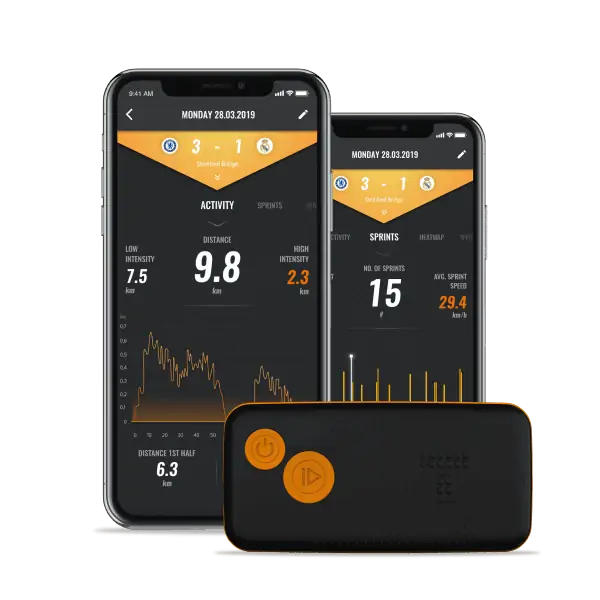
- Support portal
- Evaluation Kits and partner products
u-blox Support
- Product documentation
Documentation
- Investor relations
Investor relations
Case studies
In football , tracking, analyzing and making targeted improvements has always been a costly exercise for professionals and impossible for amateurs.
German company TRACKTICS has come up with an innovative and cost-effective solution using low-cost u-blox GNSS hardware and clever software.

For years, professional football teams around the globe have been harnessing the IoT for data collection and analysis, using insights into player performance and fitness to adjust each individual’s training regime and tactical prowess. Although the percentage gains made may seem small, they can often spell the difference between winning and losing.
To make a solution that amateur footballers could afford without compromising functionality and positioning accuracy, TRACKTICS partnered with u-blox and its GNSS hardware. The result is the TRACKTICS tracker in a comfortable waistbelt .
Tracking and monitoring devices are used by professional football teams across the world, but their hefty price tag has kept them out of reach of the non-pro leagues and amateurs. Team packages can typically cost more than €100k plus extra in annual support and consultancy services.
Drawing on research within the amateur football ranks, TRACKTICS knew they needed to develop a product in the sub €150 price range. Beyond the design constraints – it needed to be comfortable and lightweight – major considerations from a cost perspective were the price of the positioning modules and data packages.
Collecting accurate PVT (position, velocity, and time) data is critical to the solution. Though cheaper, a single-constellation GPS module would not provide the data accuracy needed to gain meaningful insights. Multi-constellation high precision GNSS receivers that integrate GNSS correction data can – all the way down to one centimeter – but they, too, come at a cost.
However, the decision was not only single constellation vs. multi-constellation. What was even more crucial was "raw data receivers" vs. "PVT receivers".
PVT receivers pre-process the data on the chip and "only" give you PVT (and lots of additional auxiliary data, but no actual "raw" data). Raw Data receivers give you access to everything and lets you do the processing yourself. You could therefore do the processing adapted to your specific needs. However, the problem is that raw data receivers are more expensive because they give you full access to the data, and PVT receivers are cheaper, but are less flexible. So, we knew we needed the best PVT receiver available, and after a lot of research, we decided on the CAM-M8 from u-blox.
After considering and trialing several design options, TRACKTICS settled on a comfortable waistbelt . The challenge was to integrate and augment a cost-efficient GNSS chip that would deliver high accuracy, despite a sub-optimal wearing position (for GNSS) and a generally difficult environment (built-up areas). The u-blox M8Q was the only GNSS chip they could find that provided the solution.
They then turned their attention to the hardware that would be embedded into it. It was clear that accurate positioning was a must to analyze objective performance data, including velocity, position, acceleration, and orientation. Consideration also needed to be given to the line-of-sight limitations of satellite constellations when players were in built up areas.
Having considered the options, TRACTICS determined that, rather than using a more costly high precision positioning receiver, the optimal solution for their specific needs would be to deploy a basic multi-constellation GNSS chipset from u-blox and augment its positioning capabilities with data from acceleration, magnetic field, and rotation rate sensors. In addition, they utilized the chipset's auxiliary data streams plus well-designed algorithms to make the data more accurate.
By applying software-based logic to the data received from the u-blox chipset, TRACKTICS was able to bring continuous positioning accuracy down to a meter , (in good environments) enough to provide sufficient data points for meaningful analysis. TRACKTICS opted for Wi-Fi to transfer data collected by the device to each player’s phone, tablet, or PC, where performance activity, recommendations, and rewards are presented within an app.
Their affordable solution is available to anyone who wants to improve their performance - just like the pros.

For a reliable and cost-effective GNSS solution, Tracktics partnered with u-blox.
Specifically, Tracktics utilizes the following from u-blox:
|
“We have been able to design and launch a professional football level monitoring solution, but for amateurs and at a fraction of the cost. By combining the u-blox GNSS module with our own algorithms and sensors, the data we collect and play back to amateurs through our app gives amazing feedback on how to improve performance.” Patrick Haas, co-founder and CTO of Tracktics |